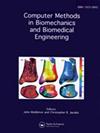Scaled generic and fetus-specific musculoskeletal modeling for simulating posterior arm delivery in the shoulder dystocia management.
IF 1.6
4区 医学
Q3 COMPUTER SCIENCE, INTERDISCIPLINARY APPLICATIONS
Computer Methods in Biomechanics and Biomedical Engineering
Pub Date : 2025-07-16
DOI:10.1080/10255842.2025.2532814
引用次数: 0
Abstract
Current childbirth simulations lack realism due to oversimplified fetal models. This study introduces a foetus-specific musculoskeletal model to simulate posterior arm delivery in shoulder dystocia and compares it to a scaled adult-to-foetus model. Using medical imaging and synthetic kinematic data, the fetal model showed notable differences in joint and muscle behaviors, with up to 39 mm deviation in elbow movement. This is the first use of a foetus-specific model for simulating delivery complications, highlighting its clinical relevance for improving accuracy in childbirth simulations and identifying potential risk factors in complex deliveries.
肩难产管理中模拟后臂分娩的通用和胎儿特异性肌肉骨骼模型。
由于胎儿模型过于简化,目前的分娩模拟缺乏真实感。本研究引入胎儿特异性肌肉骨骼模型来模拟肩部难产的后臂分娩,并将其与成人-胎儿模型进行比较。通过医学成像和综合运动学数据,胎儿模型在关节和肌肉行为上显示出显著差异,肘部运动偏差高达39毫米。这是首次使用胎儿特异性模型来模拟分娩并发症,强调了其在提高分娩模拟准确性和识别复杂分娩中潜在危险因素方面的临床意义。
本文章由计算机程序翻译,如有差异,请以英文原文为准。
求助全文
约1分钟内获得全文
求助全文
来源期刊
CiteScore
4.10
自引率
6.20%
发文量
179
审稿时长
4-8 weeks
期刊介绍:
The primary aims of Computer Methods in Biomechanics and Biomedical Engineering are to provide a means of communicating the advances being made in the areas of biomechanics and biomedical engineering and to stimulate interest in the continually emerging computer based technologies which are being applied in these multidisciplinary subjects. Computer Methods in Biomechanics and Biomedical Engineering will also provide a focus for the importance of integrating the disciplines of engineering with medical technology and clinical expertise. Such integration will have a major impact on health care in the future.

 求助内容:
求助内容: 应助结果提醒方式:
应助结果提醒方式:


